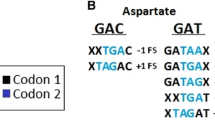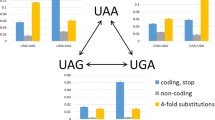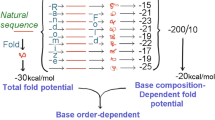Summary
The posited universal cause of codon disappearance, extreme genomic % GC, is apparently not required for codon reassignment. Rigorously interpreted, this does not eliminate codon disappearance as a contributor to reassignment, but it implies that all reassignments are unlikely to be so caused. Even more significantly, the rationale for the axiom that reassigned codons must first disappear has been eliminated. That is, it has been asserted that a codon with two meanings would be lethal (Osawa and Jukes 1989). A complete inability to distinguish serine and leucine is of course lethal. However, a state of reduced ambiguity in which CUG means both serine and leucine not only stably exists in wild-type organisms in which leucine-to-serine reassignment has occurred, but such ambiguity may even have a favorable, rather than a lethal, phenotype.
The potential list of possible ambiguous intermediates has been expanded by the discovery of the multiple amino acid specificity of Candida Ser- and Leu-tRNASer (Suzuki et al. 1997). Other means of making codons ambiguous, such as ribosomal ambiguity or unusual concentrations or sequences of particular tRNAs, are easily envisioned. We look forward to further fossil ambiguous states and further elucidation of their phenotypes. From such data we may ultimately be able to deduce the forces that occasionally drive modern codons from one meaning to another.
Similar content being viewed by others
References
Barrell BG, Bankier AT, Drouin J (1979) A different genetic code in human mitochondria. Nature 282:189–194
Dix DB, Wittenberg WL, Uhlenbeck OC, Thompson RC (1986) Effect of replacing uridine 33 in yeast tRNAPhe on the reaction with ribosomes. J Biol Chem 261:10112–10118
Jukes TH, Osawa S (1996) CUG codons in Candida spp. J Mol Evol 42:321–322
Kawaguchi Y, Honda H, Morimura TJ, Iwasaki S (1989) The codon CUG is read as serine in a asporogenic yeast Candida cylindracea. Nature 341:164–166
Keeling PJ, Doolittle WF (1996) A non-canonical genetic code in an early-diverging eukaryotic lineage. EMBO J 15:2285–2290
Leuker CE, Ernst JF (1994) Toxicity of a heterologous leucyl-tRNA (anticodon CAG) in the pathogen Candida albicans: in vivo evidence for non-standard decoding of CUG codons. Mol Gen Genet 245:212–217
Osawa S, Jukes TH (1989) Codon reassignment (codon capture) in evolution. J Mol Evol 28:271–278
Osawa S, Jukes TH (1995) On codon reassignment. J Mol Evol 41:247–249
Osawa S, Jukes TH, Watanabe K, Muto A (1992) Recent evidence for evolution of the genetic code. Microbiol Rev 56:229–264
Pesole G, Lotti M, Alberghina L, Saccone C (1995) Evolutionary origin of nonuniversal CUGSer codon in some Candida species as inferred from a molecular phylogeny. Genetics 141:903–907
Santos MAS, Keith G, Tuite MF (1993) Nonstandard translational events in Candida albicans mediated by an unusual seryl-tRNA with a 5′-CAG-3′ (leucine) anticodon. EMBO J 12:607–616
Santos MAS, Perreau VM, Tuite MF (1996) Transfer RNA structural change is a key element in the reassignment of the CUG codon in Candida albicans. EMBO J 15:5060–5068
Schultz DW, Yarus M (1994) Transfer RNA mutation and the malleability of the genetic code. J Mol Biol 235:1377–1380
Schultz DW, Yarus M (1996) On malleability in the genetic code. J Mol Evol 43:597–601
Suzuki T, Ueda T, Watanabe K (1997) The ‘polysemous’ codon—a codon with multiple amino acid assignment caused by dual specificity of tRNA identity. EMBO J 16:(in press)
Tourancheau AB, Tsao N, Klobutcher LA, Pearlman RE, Adoutte A (1995) Genetic code deviations in the ciliates: evidence for multiple and independent events. EMBO J 14:3262–3267
Ueda T, Suzuki T, Yokogawa T, Nishikawa K, Watanabe K (1994) Unique structure of new serine tRNAs responsible for decoding leucine codon CUG in various Candida species and their putative ancestral tRNA genes. Biochimie 76:1217–1222
Yarus M, Cline SW, Wier P, Breeden L, Thompson RC (1996) Actions of the anticodon arm in translation: on the phenotypes of RNA mutants. J Mol Biol 192:235–255
Author information
Authors and Affiliations
Rights and permissions
About this article
Cite this article
Yarns, M., Schultz, D.W. Response. J Mol Evol 45, 3–6 (1997). https://doi.org/10.1007/PL00006171
Issue Date:
DOI: https://doi.org/10.1007/PL00006171




